The “Via Francigena and the European Cultural Routes” magazine honours our initiative with a special edition, entirely dedicated to the European march that celebrates the 20th anniversary of the European Association of Via Francigena ways (EAVF).
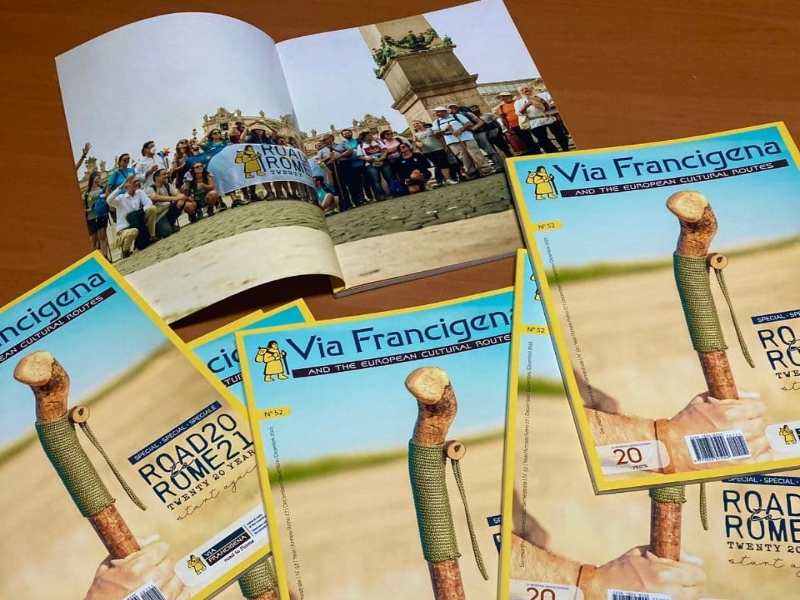

The “Via Francigena and the European Cultural Routes” magazine honours our initiative with a special edition, entirely dedicated to the European march that celebrates the 20th anniversary of the European Association of Via Francigena ways (EAVF).

We wish to share a message for a Merry Christmas by Joseph de Metz-Noblat, Bishop of Langres and President of “Spiritualitas in Francigenam”, directed at the community of pilgrims and the EAVF:
Oh, how long are these nights at the beginning of winter. I can feel it once again, as I seek a warm shelter during my long journey along the “road of the Franks” leading me to Rome.
The cold and darkness are not only natural phenomena, but they also express the difficulties this world is experiencing: the coldness of war, of violence, of every type of opposition; the darkness of ignorance, of scorn and of blindness. Who will come to warm and light up our hearts?
I recall that the small baby in his cradle was born during the longest night of the year… But is it not him the one who opens the path towards peace and hope?
Indeed, as Jesus said: “Do good to those who hate you” (Mt 5,44) and he did so during his Passion. He presents himself as “the path, the truth and the life” (Gv 14,6). Walking in the countryside, I appreciate the signposts and the suggestions of local people, helping me to find my path. Maybe even on the path of my life?
This Christmas, I understand there is no need to be afraid, because Jesus is the light of the world (cfr. Gv 8,2).
Joseph de Metz-Noblat, Bishop of Langres, President of Spiritualitas in Francigenam
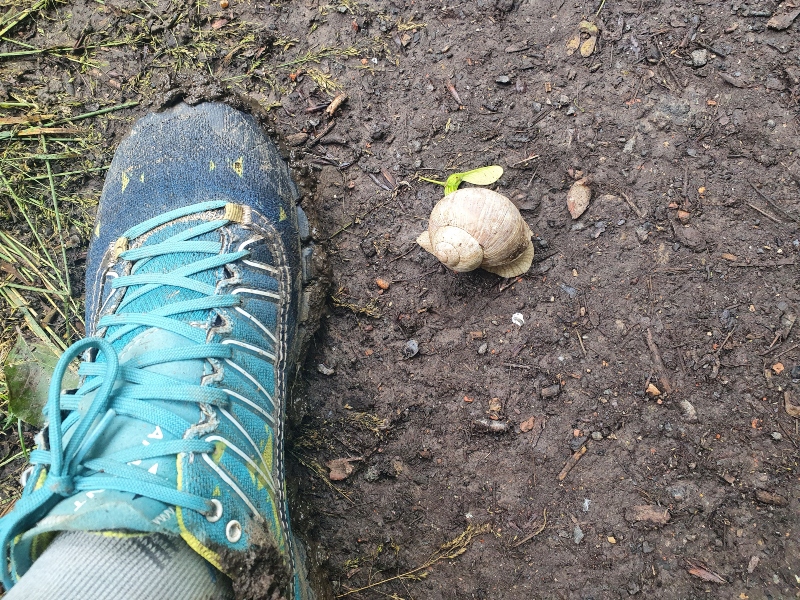
Every long journey begins with a first step
Every journey begins before departure. It begins in our head, when it takes shape. The idea of the long march “Road to Rome 2021” was conceived in a specific moment, in the month of August 2020, at the end of the Road Trip along the Via Francigena which brought me to walk with Elena along the 10 Swiss stages of the Via, meeting municipalities and associations.
“Why not propose a similar initiative along the entire Via Francigena to celebrate the first 20 years of the Association, founded in Fidenza on 7 April 2001?” Easier said than done. In this case, we also had to seriously consider the issues caused by the Covid pandemic, as it concerned putting 3,200 km in a sole network to organise a march that would last over four months. A journey that immediately presented itself as something epic, as “shining madness”. Afraid not to be able to make this dream come true? Yes, a lot.
The first phases of the project
We had to start somewhere. The first project concept emerged at the end of summer 2020, with the first discussion of ideas held with the European Association of Via Francigena Ways (EAVF)’s President Massimo Tedeschi, Vice-president Martine Gautheron, and, of course, all of the staff. At the beginning of autumn, discussions enlarged, involving municipalities and associations that adhere to the EAVF. We then present the project at the General Assembly on 23 October 2020 and recognised a lot of enthusiasm about this potential idea: there was a lot of participation and of moral support. The first stone had been cast and it started to roll very quickly. The organizational machine was launched.
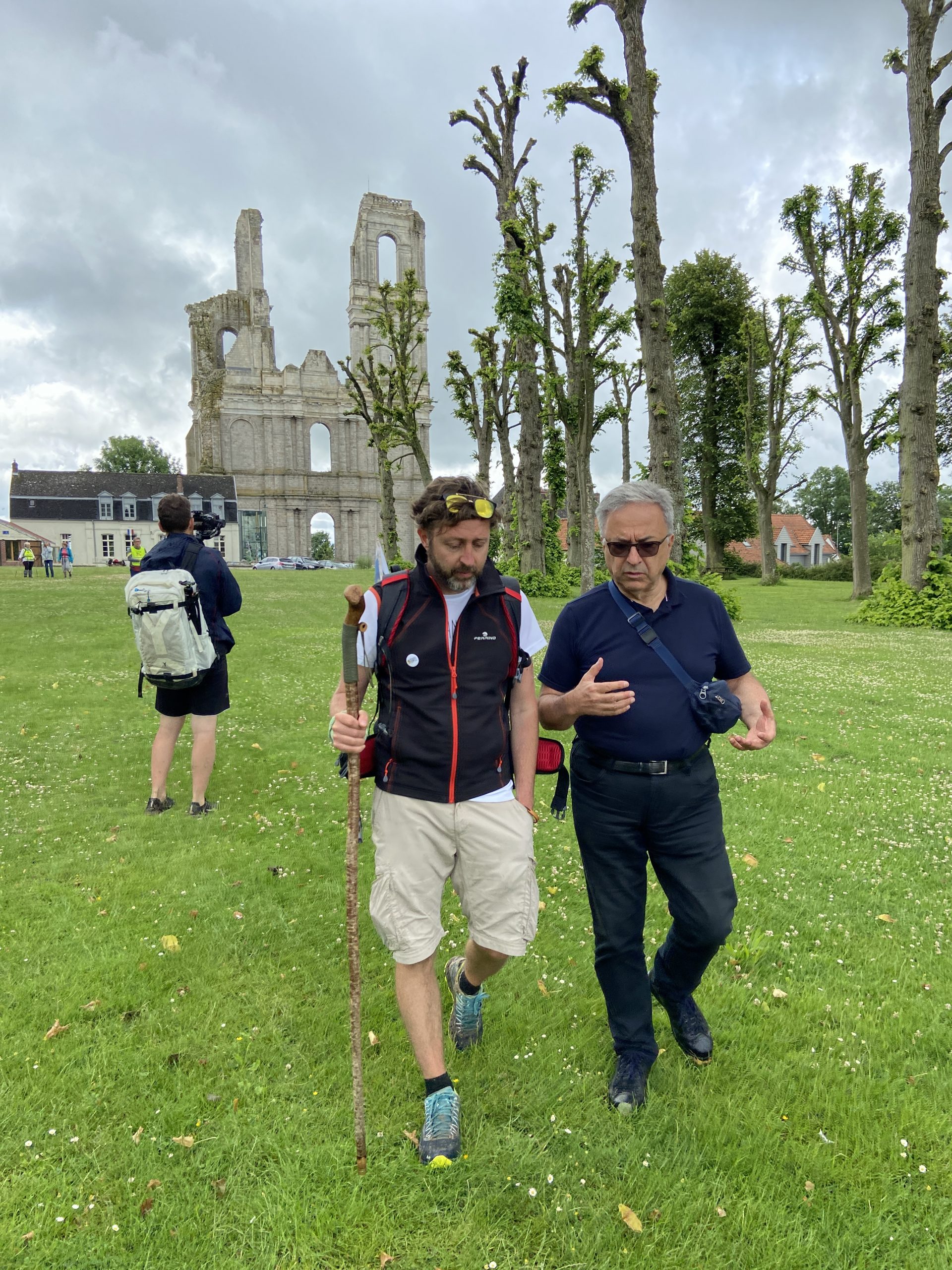
We started to broaden the project, defining it in the various phases and objectives we wanted to give ourselves. In the meantime, the idea of a relay march was born. It is nice to imagine that there will be a stick to symbolically accompany us from Canterbury to Santa Maria di Leuca, on foot and by bicycle. It is also the year of bicycles at Tokyo’s Olympics, the Olympics delayed from 2020 to 2021. So, we too will play our Olympic games, and accompany the journey with the pilgrim’s staff, that replaces the torch – symbol of the Olympics, which are based at the International Olympic Committee headquarters located in the beautiful city of Lausanne, significant spot along the Via Francigena in Switzerland. We will have our own marathon – not a competitive one of course – for over 3 thousand kilometres. Oh dear, this is crazy. My legs were already shaking only at the idea and thinking about the upcoming months.
“How do we want to create this official stick, which will walk with us?” Our English friends from the Confraternity of Pilgrims to Rome (London), long lasting supporters of the Via Francigena, helped us in this process. President Giancarlo Laurenzi searched for support in the creation of our pilgrim’s “torch”. After all, a stick made of hazelwood will be devoted to the initiative, provided 3 years ago by Michael Walsh, pilgrim and artisan, in the surroundings of the Holycross Abbey in Tipperary, Ireland. The stick has already been cured, cleaned and prepared for the long journey with over 10 layers of boiled linseed oil. The decoration on the stick will be carved by local artist Julie Helen Sharp, and the rope grip on the handle will be prepared by the specialised craftsman Declan O’Shea. Wow. Symbols are also an important element of this journey. This stick will go a long way, a very long way.
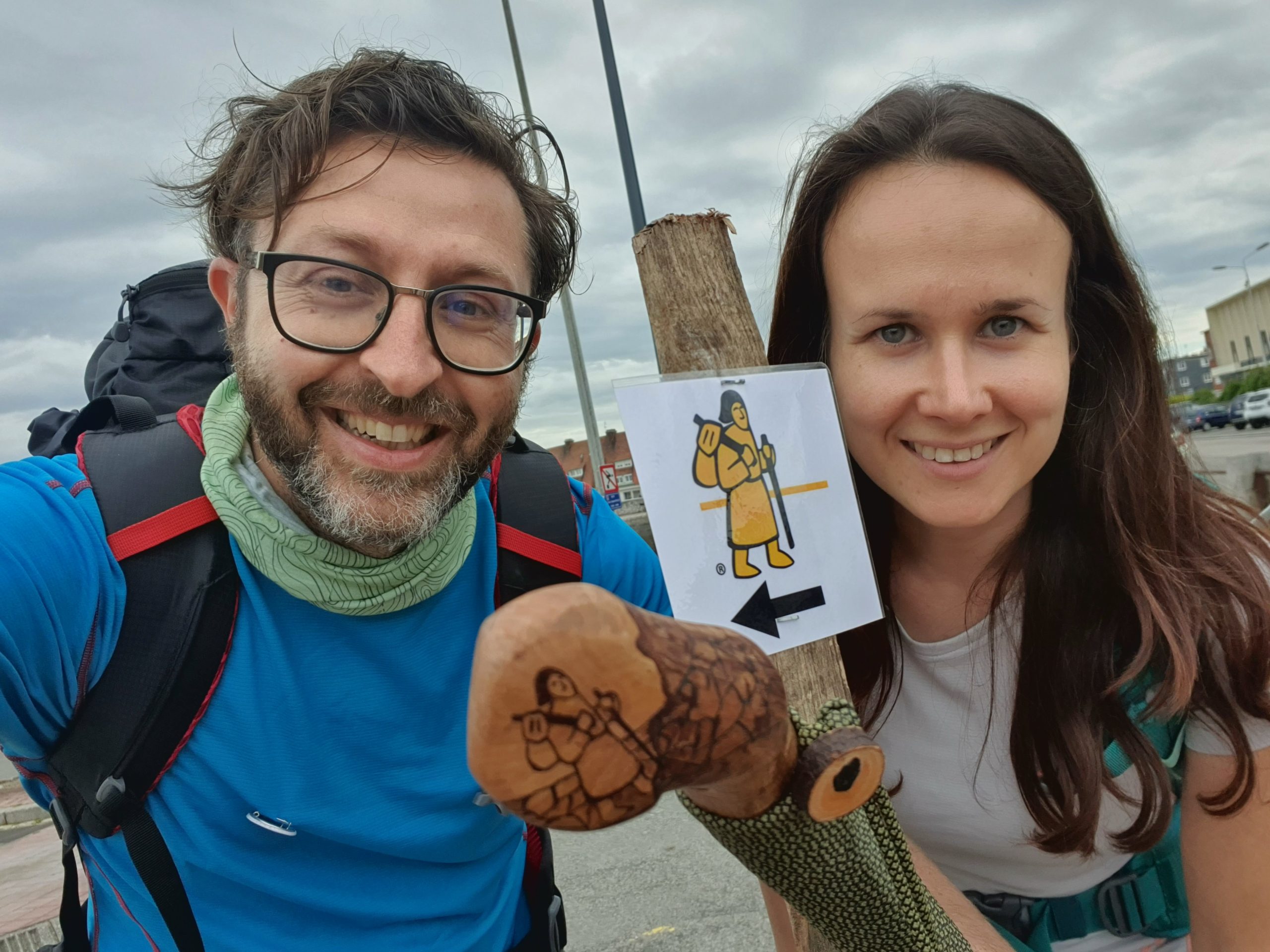
The name of the event still needs to be defined. After long discussions and debates, the EAVF group unanimously agreed on the proposal “Via Francigena. Road to Rome”. This name is connected to the desire to reinforce the close link between the name Via Francigena (a name which, outside Italy, is not so easy to pronounce) and its destination, Rome. You arrive and you depart from Rome, also to head south toward the marvellous lands of Apulia. “Start again!” was then added to “Road to Rome”, an additional proposal by President Tedeschi. The initial idea was to use “We’ll meet again”, an idea that arrived from the UK. It was, indeed, the ending of the message of the British queen to her population on Sunday 5 April 2020 on BBC, during a very uncertain phase amid the Covid pandemic. You may say it is apparently a statement as another, but it is not. It was the hopeful text of a song from the II World War. The Via Francigena family, too, wants to go back to see each other, and peacefully meet along the Via.
Let’s try and organise team and workload, both on the road and in back-office
Behind every project there must be a team leading and developing it. There must be a trainer guiding the team, even in the middle of a storm. Well, the trainer is our super-President Massimo Tedeschi, who has been convinced since day 1 about undertaking this event and bringing it to completion. I had the burden and honour of coordinating – both on and out of the field – an extraordinary staff that progressively augmented, going up to 24 people[1] including tireless interns that gave an important contribution to the success of the project. The staff worked behind the scenes, directing the project, but also had important role along the route, with at least one person always physically present with the walking group. The team is essential. As in an orchestra, each component has its own role and plays in harmony with the others. For me it was an honour, above everything, to conduct this orchestra.
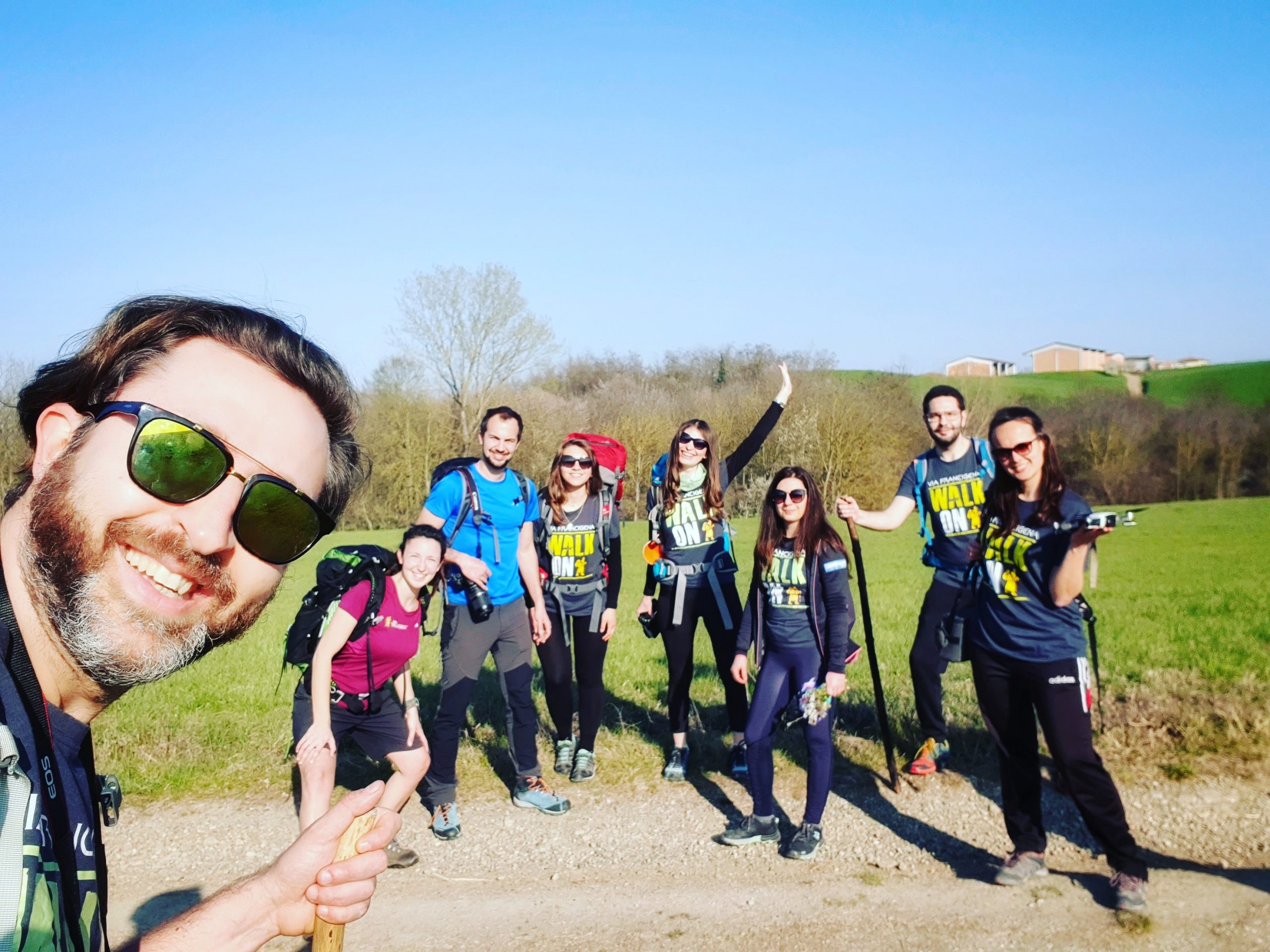
Yet, who will be following the journey for EAVF and share it on our social media channels every day? For this fundamental role, we soon realised we already had the right person ‘on board’, at the right moment, in the right place. With the right enthusiasm: Myra Stals, Dutch girl that had just started collaborating with us for the European project rurAllure Horizon 2020, in which EAVF is involved. Yes, Myra would have been the face of this epic journey. The same girl that travelled most of Europe in the last few years with her cargo bike, leading environmental awareness campaigns. The Santiago de Compostela trail is male, and the Via Francigena is female. We could not do differently than choosing an official woman walker.
In the meantime, we tried to set the departure date. We begin on 15 June, from the ‘km 0’ at the Cathedral of Canterbury.
Municipalities and associations are on our side
Already during the initial phases, involvement of municipalities in the project represented an essential component. Firstly, because it allowed to organise hospitality and refreshments upon arrival in each stage, secondly because they supported the political value of this journey, which built a network of 657 municipalities located along the 4 crossed countries. Most of them believed in us from the very first moment, strongly embracing our coral initiative. National, regional and local associations also had an equally important and decisive role, becoming real “Trail’s Angels” for our trip. They helped us during the initial phase by defining the exact route and during the entire event by guiding us along it, holding us by hand and leading us to understand, once again, the importance of associations for the development of the Via Francigena and of local initiatives.
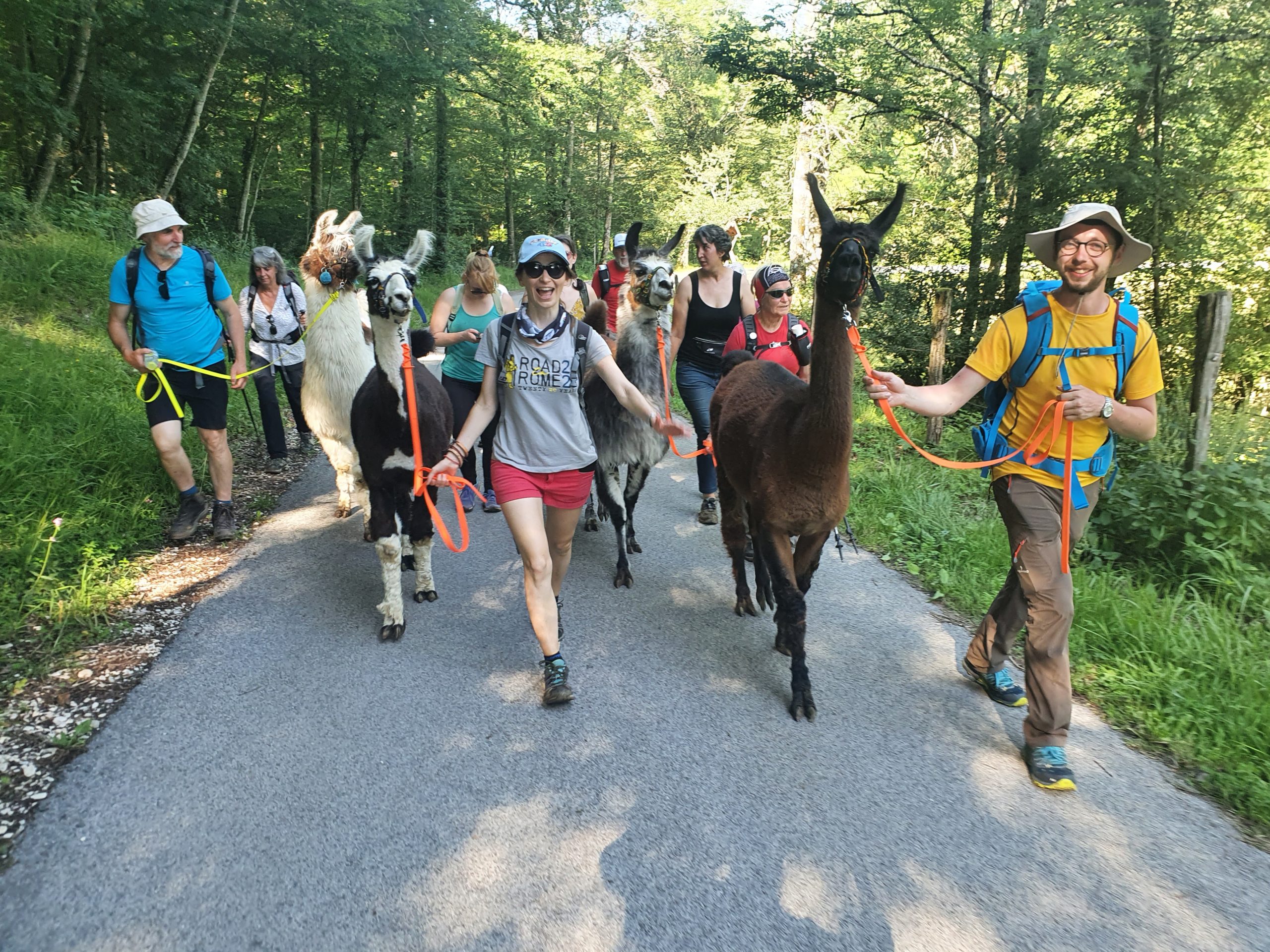
Refining the on-the-road team. Video makers and ambassadors will travel too!
The role of photographers and video makers was fundamental. Thanks to eight professionals[2] coordinated by the trio Stefano, Roberto and Camilla it was possible to report the long trip from the first to the last kilometre. But let’s take one step back. Precisely for this reason a call for proposals was launched in March 2021 to seek a trusted project partner which could join us in the event, collecting photos, images, videos, interviews and reels. The group SL Studios won the call, bringing together a group of talented young people that would follow us with their cameras, drones and remarkable professionality, ready to get on and off their bike to stay with the group every day, with their big backpacks on their shoulders.
A separate chapter should be reserved to bloggers, promoted to become central ‘ambassadors’ of “Road to Rome”. In April 2021, EAVF launched a second call for proposals for bloggers, inviting them to walk with us for a small part of the route. Over a hundred people answered! We could only select 28 of them, which would join us along very specific sections of the route with an average of 5 days. We were strongly convinced that their stories, blogs and videos, but also their fresh characters and their smiles, could provide added value to the initiative. Bloggers would become a very important element for the outreach potential of the project, but also to stimulate greater empathy with the public.
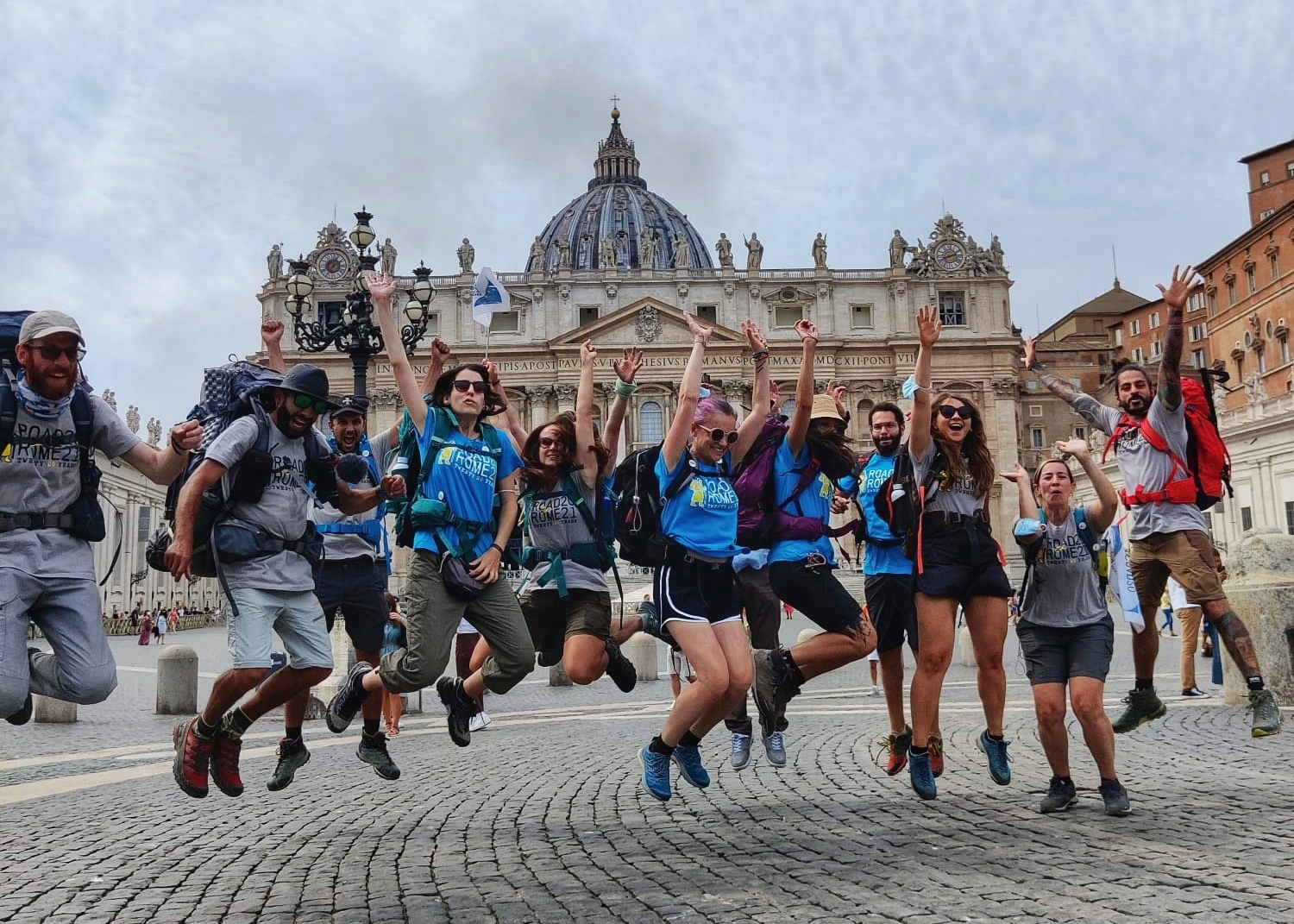
Here come partners and sponsors. If we want to do things properly, we need an economic plan and people to help us finance the project
We immediately realised that, to organise such a big, complex and ambitious event, our commitment and the ordinary resources of the association were not enough, despite the significant effort it demanded. We needed appropriate economic resources to face this epic relay march, to support it fully and communicate it to the public.
First of all, “Road to Rome” has been conceived as a proper working position (on top of a good dose of fun), to sensitise local institutions towards an increasing investment of energies and resources on the Via Francigena. Among the final objectives are the UNESCO candidacy of the itinerary from Canterbury to Rome and the official introduction of the Via Francigena in the South.
How could we reach significant sponsors and partners for the project? We found our way thanks to the extraordinary work of institutional relations, networking and project planning undertaken by the team and its friends, highlighting the values at the core of the Via Francigena Itinerary and of the 20-year-old activity of the association. One person supported and pushed us forward more than any other, since the very first moment: Mons. Liberio Andreatta, great supporter of the Via Francigena and of its spiritual and cultural value, which are at the basis of this millennial route.
Maybe “Road to Rome” really was the “right project at the right moment”, as Massimo Garavaglia, Italian Minister of Tourism, would say upon arrival in Santa Maria di Leuca. It allowed us to obtain the necessary resources to launch and consolidate this long journey and, above all, have meaningful partners on our side, supporting us.
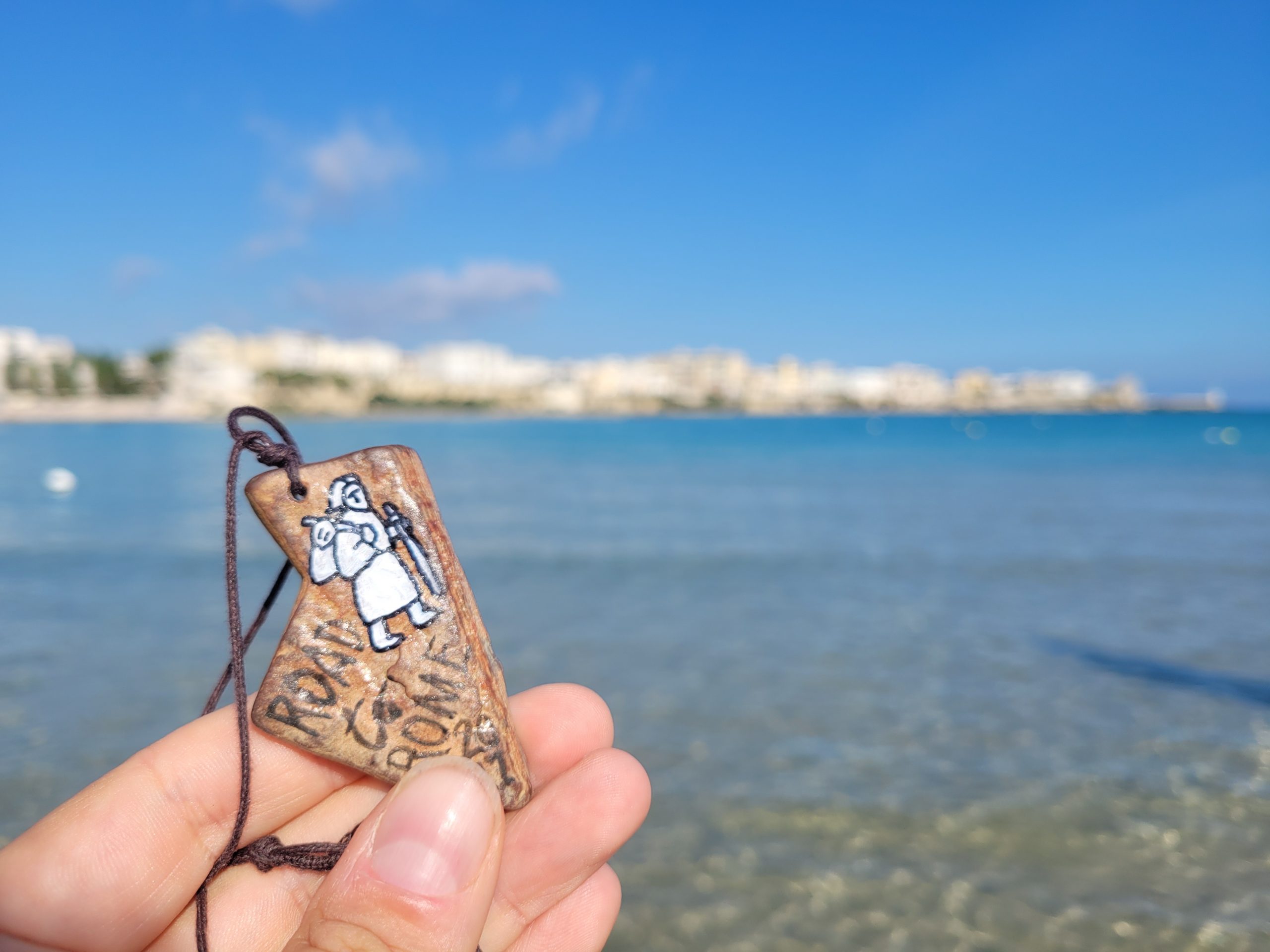
Covid. How should we behave?
The organization of the event started in autumn 2020, but Covid continued being a serious issue during the following months. There were important restrictions, ‘red areas’, lockdowns for the entire winter season. The future was quite uncertain and the organisation of the Francigena relay suffered from it. I discussed this many times with the President, the Presidency office, the staff, members, project partners and regional health authorities. There were concrete issues we could not ignore, such as quarantines, swabs, reduced mobility and a virus that was heavily circulating at the beginning of 2021. We had already begun to think about plan B and C, which is always good to have ready. There was even a hypothesis of postponing the entire event to 2022, or only organising a few symbolic section walks in 2021. The final decision to depart was only taken on 17 May 2021, after EAVF’s General Assembly in which numerous members participated compactly. The unanimous orientation was to depart, organising an event for a small group of people and avoiding big gatherings. Obviously, the health protocol had to be respected very seriously. In the meantime, at least, the green light had switched on!
Departure. From Canterbury and from the headquarters of the Council of Europe in Strasbourg
Covid restrictions forced us to change the original plan. The official Group, ready to start walking on 15 June, could not reach Canterbury in England due to entrance limitations and mandatory quarantines. Yet, the substance did not change: we were supported by Canterbury City Council, Diocese of Canterbury, Confraternity of Pilgrims to Rome and the Kent County. That day, in the morning, an evocative ceremony with the blessing of the pilgrim’s stick took place, and a group of people, guided by Giancarlo Laurenzi, started walking the English section of the Via Francigena. On the following day, in Dover, the stick was handed over to the captain of the ferry that transported it to the port of Calais, where the Road to Rome group was waiting to collect it. What an emotion to have the official stick in our hands! It is hard to imagine a better beginning than this.
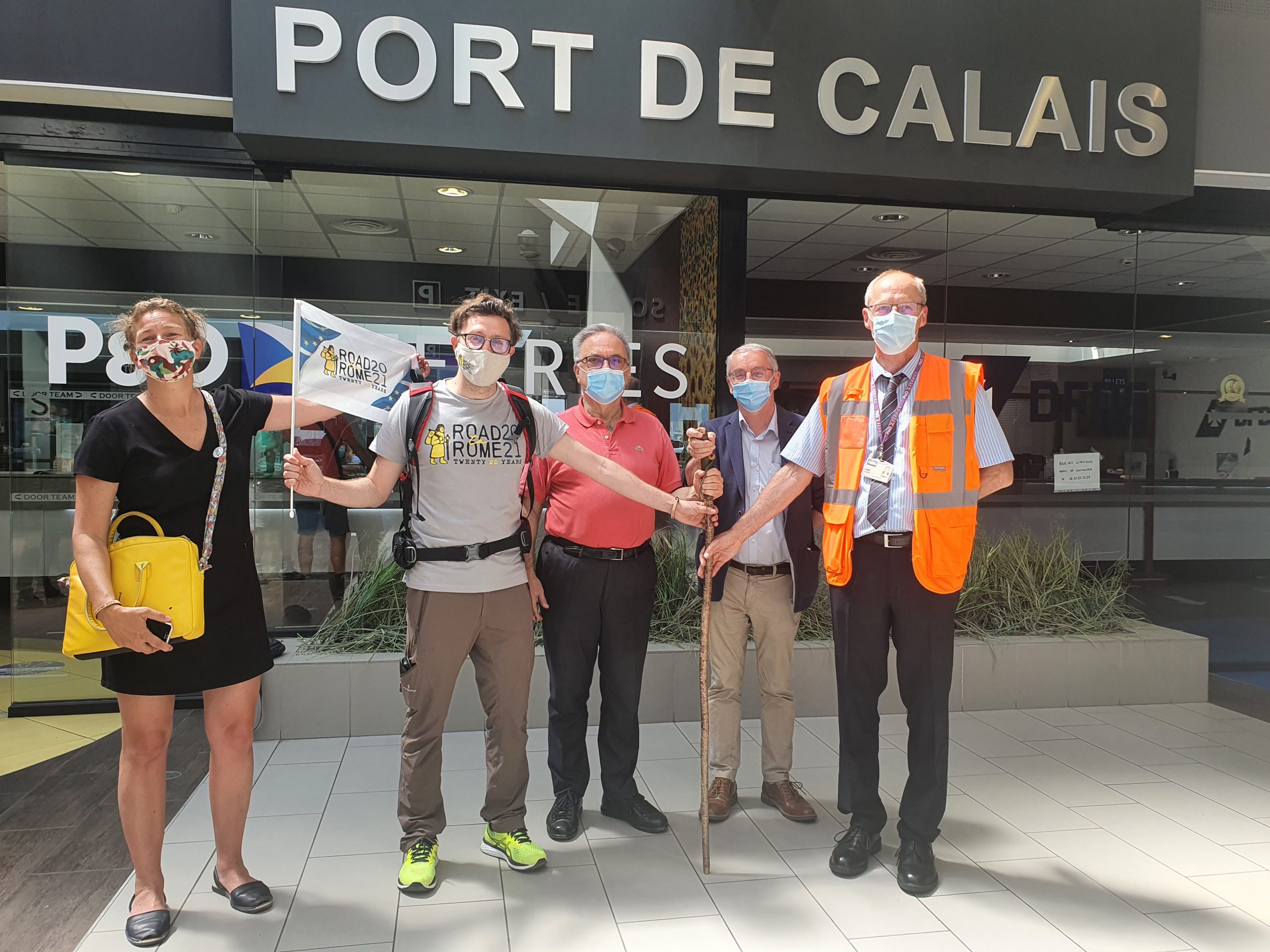
We had arrived in Calais, in the north of France, after a stop in Strasbourg on 15 June. Precisely on that day, the “Road to Rome” delegation, guided by President Massimo Tedeschi, Vice-presidents Francesco Ferrari, Gaetan Tornay, member of the Presidency Office Pierre Contoz and myself, were honoured to be welcomed by the Secretary General of the Council of Europe Marija Pejčinović Burić. Yes, it really was an honour to start our journey across Europe from the “Palais de l’Europe” in Strasbourg, where, in 1987, the Cultural Routes Programme was founded – program which the Via Francigena joined in 1994. On this occasion, the keywords of “Road to Rome” were presented: relaunch, to react to the Covid pandemic; heritage, both material and immaterial, along the route; Europe, in the widest sense of the word, including all related humanitarian values.
The journey. The departure. The stops. The arrival. The infinite beauty.
At this point, the journey begun, and we started covering kilometres, meeting people, and crossing villages, one after the other. Ever since the first day, from that fascinating opening ceremony in front of the Cathedral of Calais, we realised that something extraordinary was happening. Something epic. One of those experiences that are so strong and intense that they might never repeat.
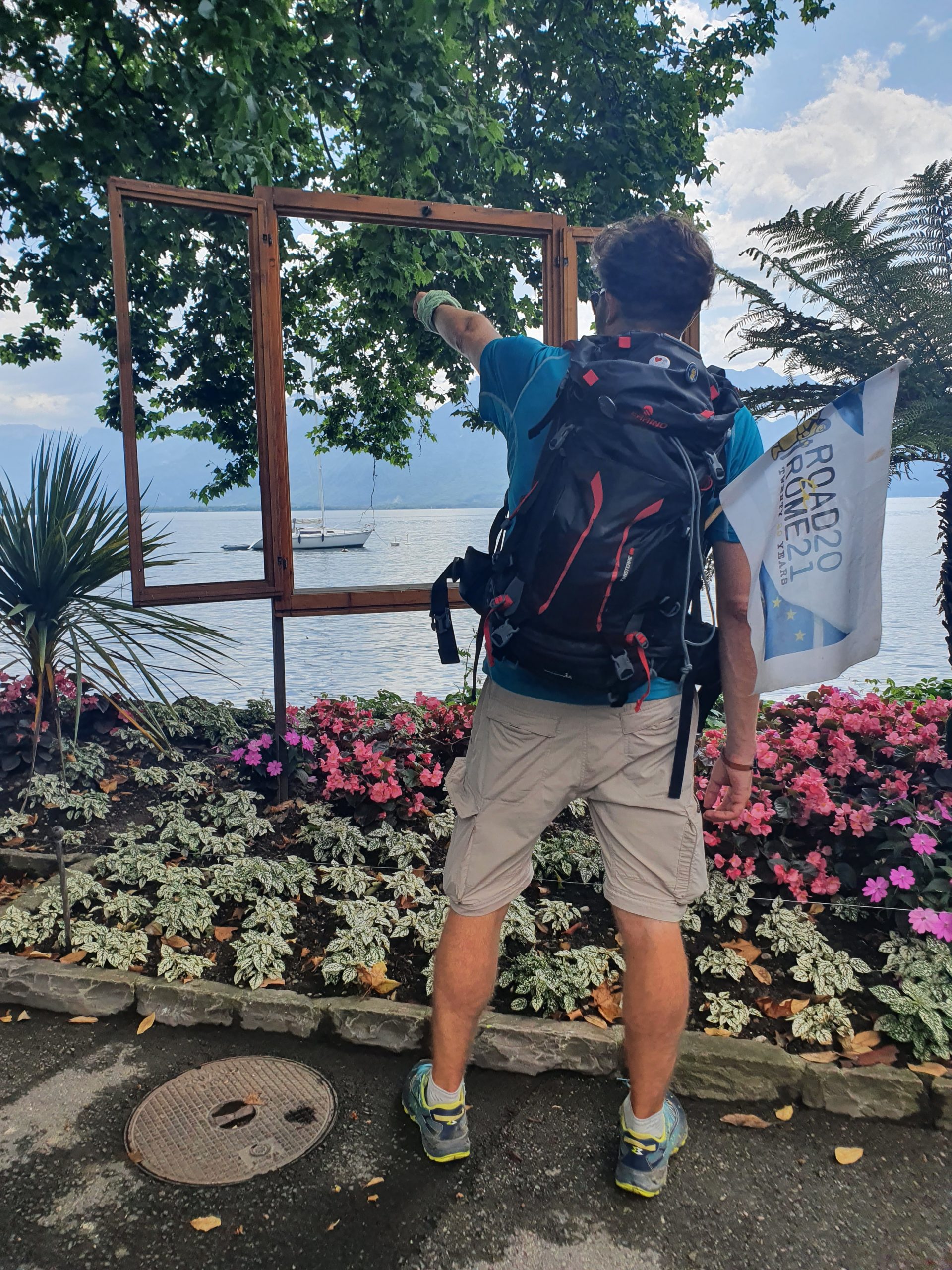
The full story of this 119-stages, 127-days, 3,200-km journey is collected in podcasts and in the daily blogs prepared by the tireless and wonderful Myra Stals, as well as in the posts on social media, in over 3,000 photos, 16 videos, 50 reels, in the pages of our bloggers and in the diary of “Ragazze in Gamba”. We really left a lot of traces behind us, along a route that crosses Europe.
During this adventure there were very important symbolic moments, such as our stops in Arras, Champlitte, Besançon in France; the unique Great St. Bernard Pass in Switzerland; Orio Litta, Gambassi Terme, Viterbo and Roma, the eternal City that we reached on 10 September; further south to Formia, Fondi, Telese Terme, Bari and ultimately the final destination, Santa Maria di Leuca, our De Finibus Terrae. A triumphant arrival that took place on Monday 18 October, under a light rain, with more than 150 following us and sharing emotions and experiences. We reached the Sanctuary and the legendary lighthouse (second tallest in Europe), representing the very end of Italy’s heel and of the “Road to Rome” journey.
We arrived in the exact spot where, according to popular common knowledge, the Adriatic Sea meets the Ionio Sea and, due to their different colours, a borderline appears in the water. We reached the southern end of this crazy European trip along the Via, which we shared with 15 thousand people in 4 months.
The emotions that arose from this journey are still strong. The faces and stories of the beautiful people we met along each stage are still shining in me. I remember the nice chats along the way, with my trip companions, our stops to eat, our early waking time, my feet soaking in water in rainy days, the colours of the fields and cultivations that change the scenery as we go; the embracing sunsets, the moments of silence, the moments of happiness that a walking journey gifts, the smell of the woods, the sound of the stick walking with me and giving the rhythm to travellers, the tiredness and the joy at the end of each day. I had an intense feeling, finally, from the smiles and hugs, true hugs that I had forgotten during the pandemic. The most beautiful and extraordinary part of this journey were the people.
Road to Rome was a journey that connected peoples, populations and territories. It gave each of us hope and pride. The Via Francigena proved to be a stunning long pearl necklace. We collected all these pearls, one by one, in the towns we crossed, and we managed to put them all together, one aside the other. A beautiful dream has come true.
Luca Bruschi, EAVF’s Director
[1] Staff: Sami Tawfik, Micol Sozzi, Elena Dubinina, Luca Faravelli, Myra Stals, Jacques Chevin, Martina D’Agostino, Sara Louise Costa, Marika Massotti, Eleonora Martinelli, Arianna Fietta, Simona Spinola, Nicole Franciolini, Cecilia Micciantuomo, Garance Potier, Edgar Lebras, Angelofabio Attolico, Giusy Baldacchino, Daniela Leo, Anna Maria Ganapini, Rosy Previ, Marco Tedeschi.
[2] Video makers: Mattia Poppa, Filippo Racanella, Andrea Ciotti, Enrico Baroni, Luce Scaglione, Sharon Di Cinci, Giulia Bertolazzi, Nicola Cagol.
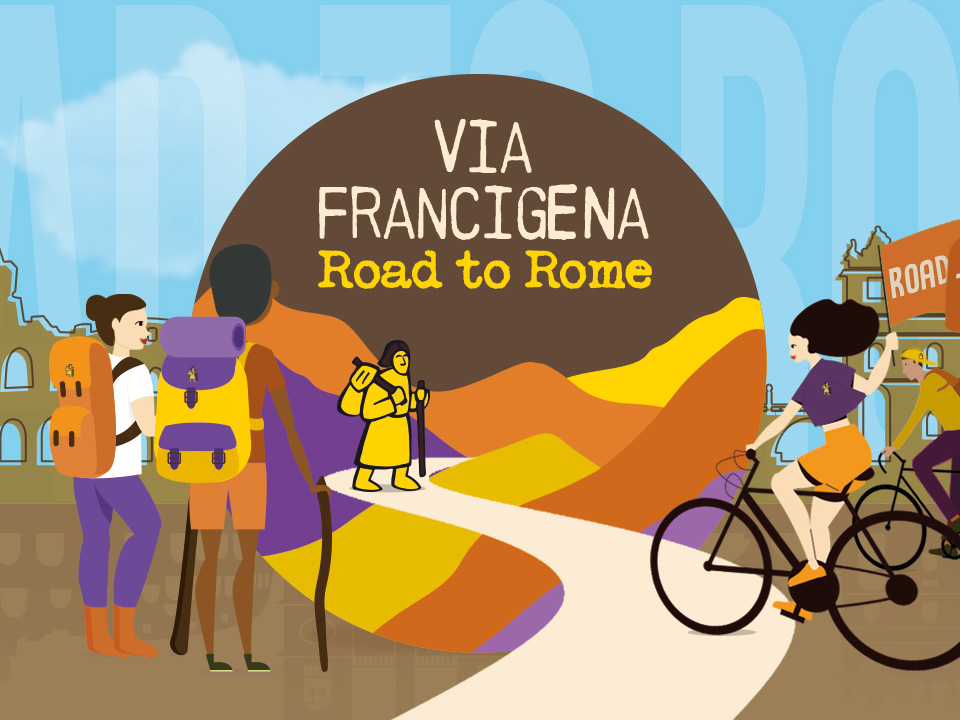
The Via Francigena creates strong connections, and what’s become clear to us after our Road to Rome adventure last summer is that many people who came to walk with us continue to feel this strong need to connect. A need to continue their journey, even if only online. They want to keep the spirit of the cammino alive, they want to continue to share their stories, their memories, their experience with those who walked alongside them or with those who just started to plan their own journey.
And this is when we realized: we need an official Via Francigena community! A place for people to come together virtually, to share all things Via Francigena, to create new connections and plan new trips.
We are therefore very happy to invite you to join the official Via Francigena – Road to Rome Facebook Group! Besides being a place to connect with fellow Via Francigena enthousiasts, our Facebook group will also offer exclusive content that you won’t be able to find anywhere else on our channels:
Our Facebook Group will be an international one, where everyone who shares our love for the Via is welcome to write and communicate in their own language. It will also be a group based on mutual respect: by following the simple group guidelines and by treating others in the same way you would like to be treated, we are convinced that our community will be a great place to hang out.
So… what are you waiting for? Join our Via Francigena – Road to Rome community now by clicking on this link: https://www.facebook.com/groups/655350489151864
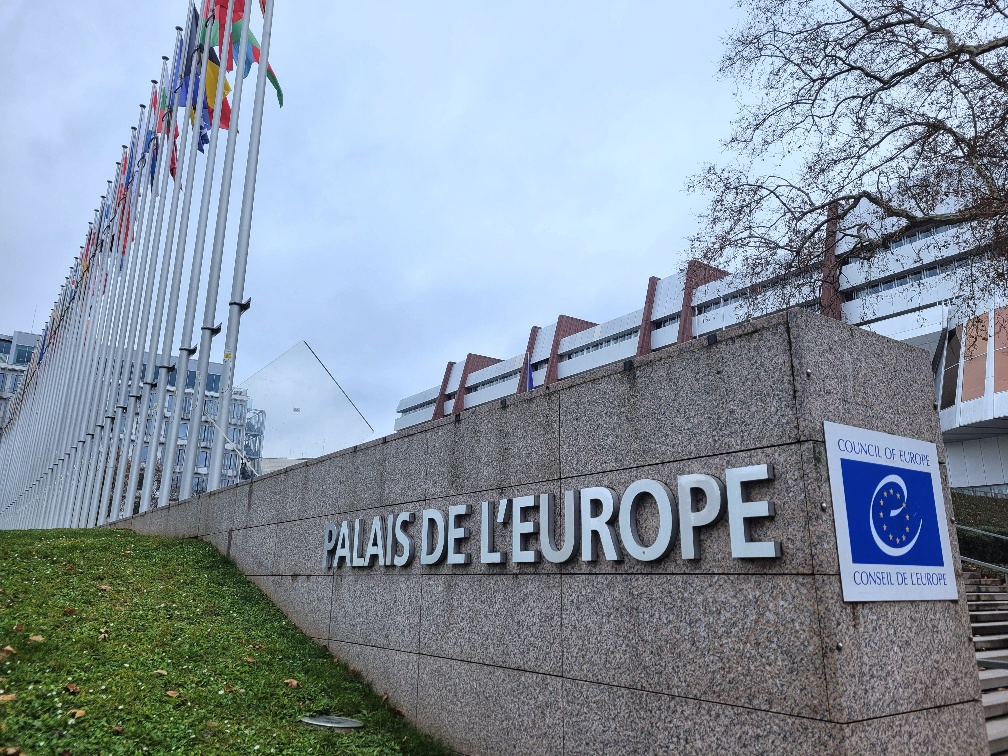
The exhibition “Cultural routes of the Council of Europe in Italy: European heritage” celebrates the Italian Presidency at the Committee of Ministers of the Council of Europe. Exhibited at the headquarters of this international organisation in Strasbourg, it highlights the 29 routes, out of 45, which are managed by associations based in Italy or have a strong network in this country.
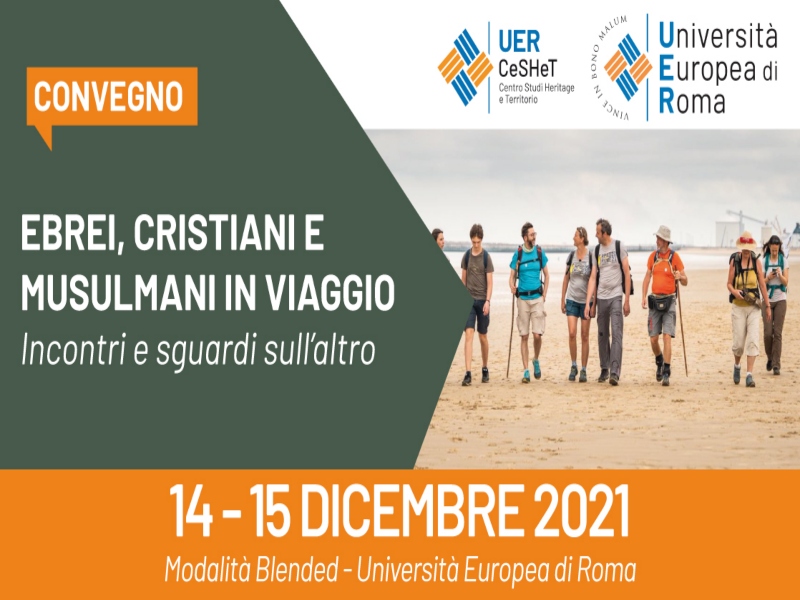
The European Association of Via Francigena ways (EAVF) will take part in a two-day conference in Rome on 15 December 2021 dedicated to traveling and the storytelling of journeys, venturing between historical routes and modern itineraries, between wayfaring and pilgrimage.
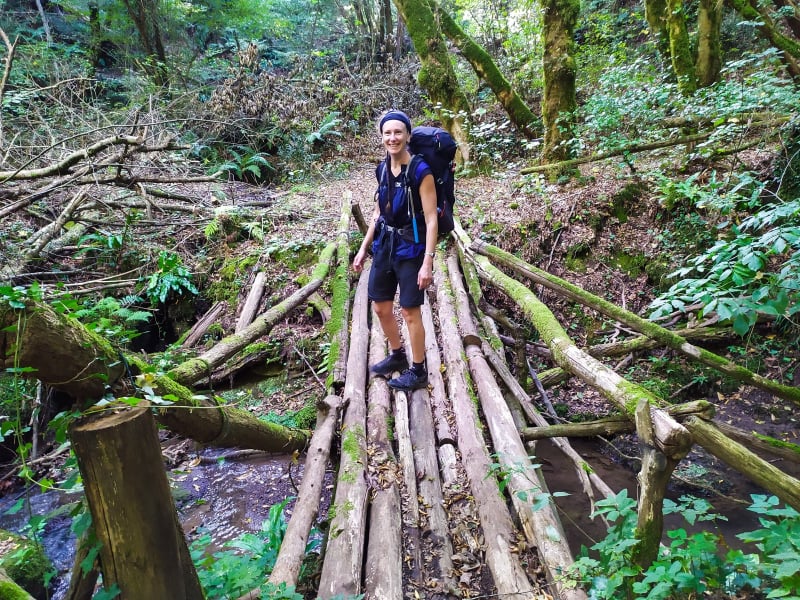
Nicoletta walked the Via Francigena on her own in October and told me about her experience in an interview for the #storiediragazzeingamba column.

Luca Bruschi, Director of the European Association of Via Francigena ways (EAVF), frontline walker during the Road to Rome 2021 and passionate promoter of the Via Francigena, will take part in the conference, open to the public, ‘The Way of Saint Benedict and the ancient roads in the Latin Valley’, in Cassino on 19 December 2021.
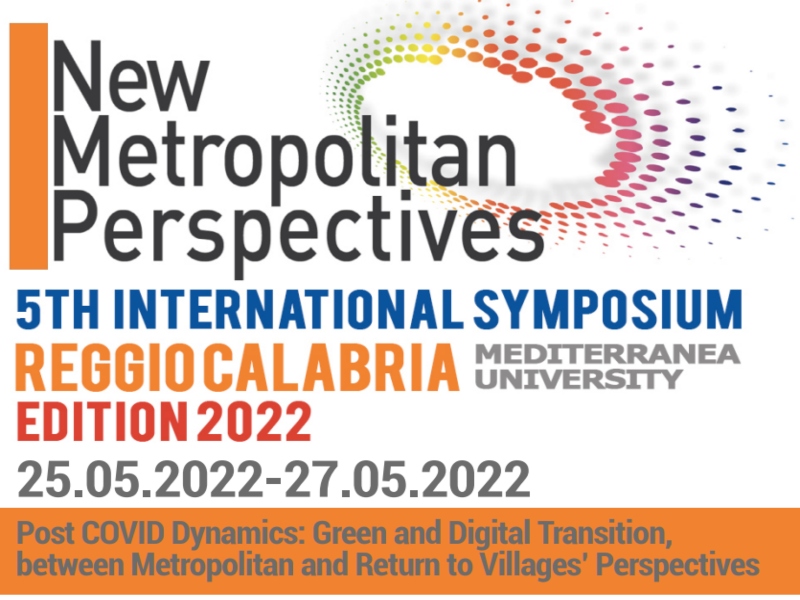
Between 25 and 27 May 2022 a session focused on cultural routes will take place in Reggio Calabria (Italy), aiming to debate on routes as a tool for innovation and tourism recovery after the recent pandemic crisis.
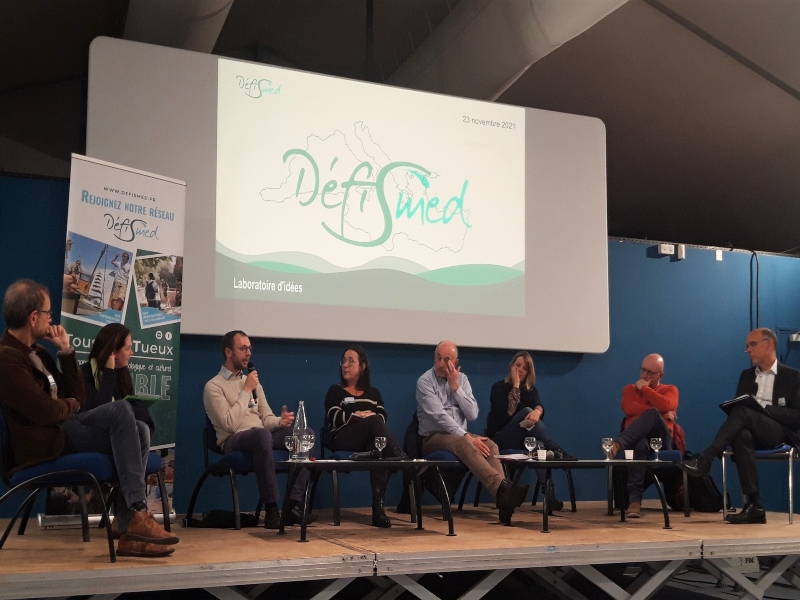
On the 22nd and 23rd of November 2021, EAVF took part in two days of conferences in Antibes (along the French Riviera) organized by the Défismed association, in collaboration with the French Ministry of Culture.